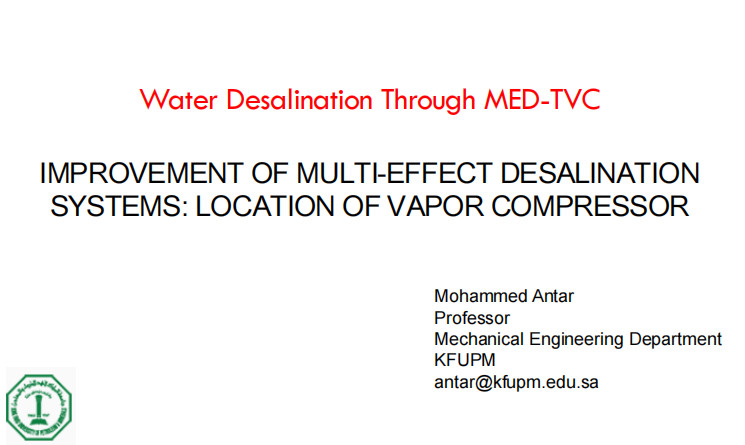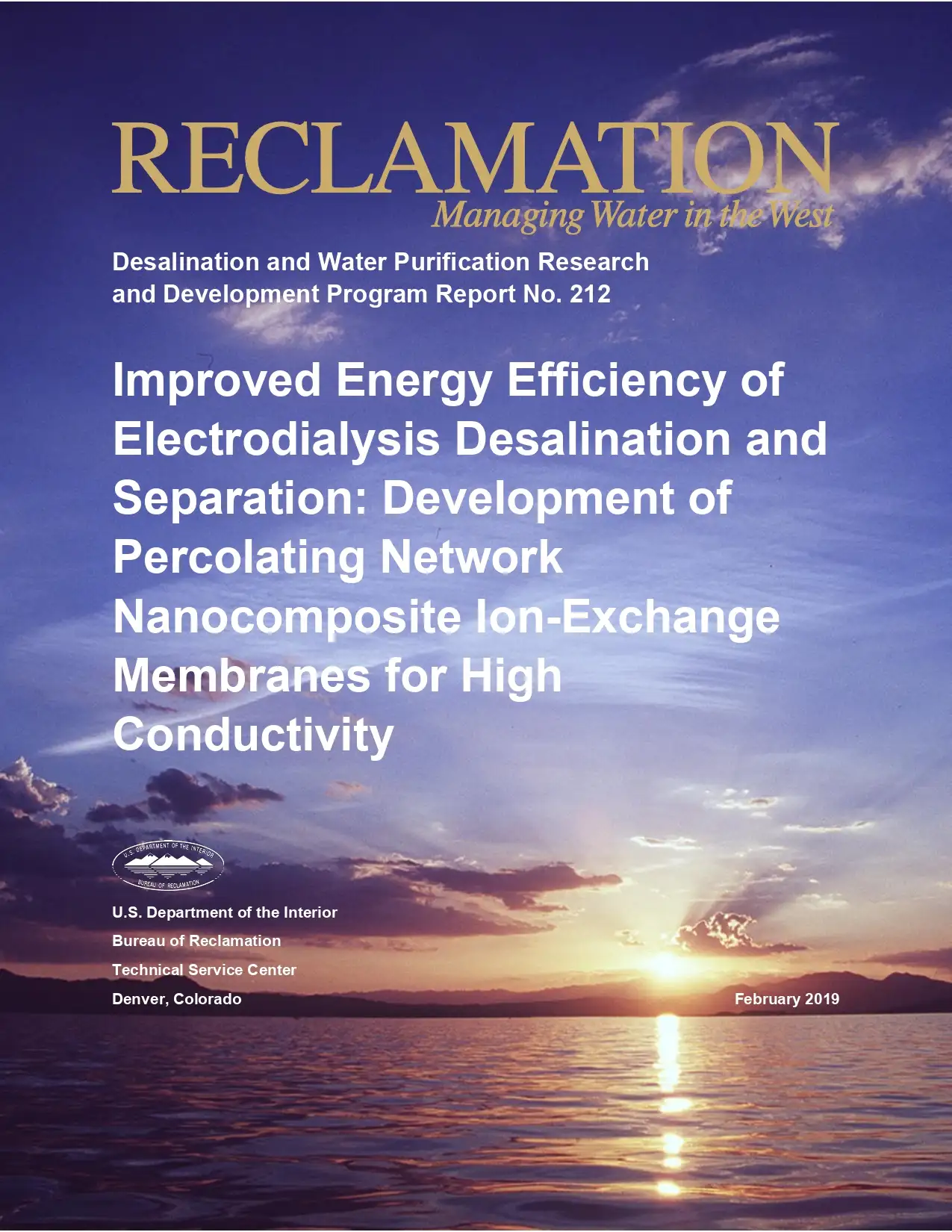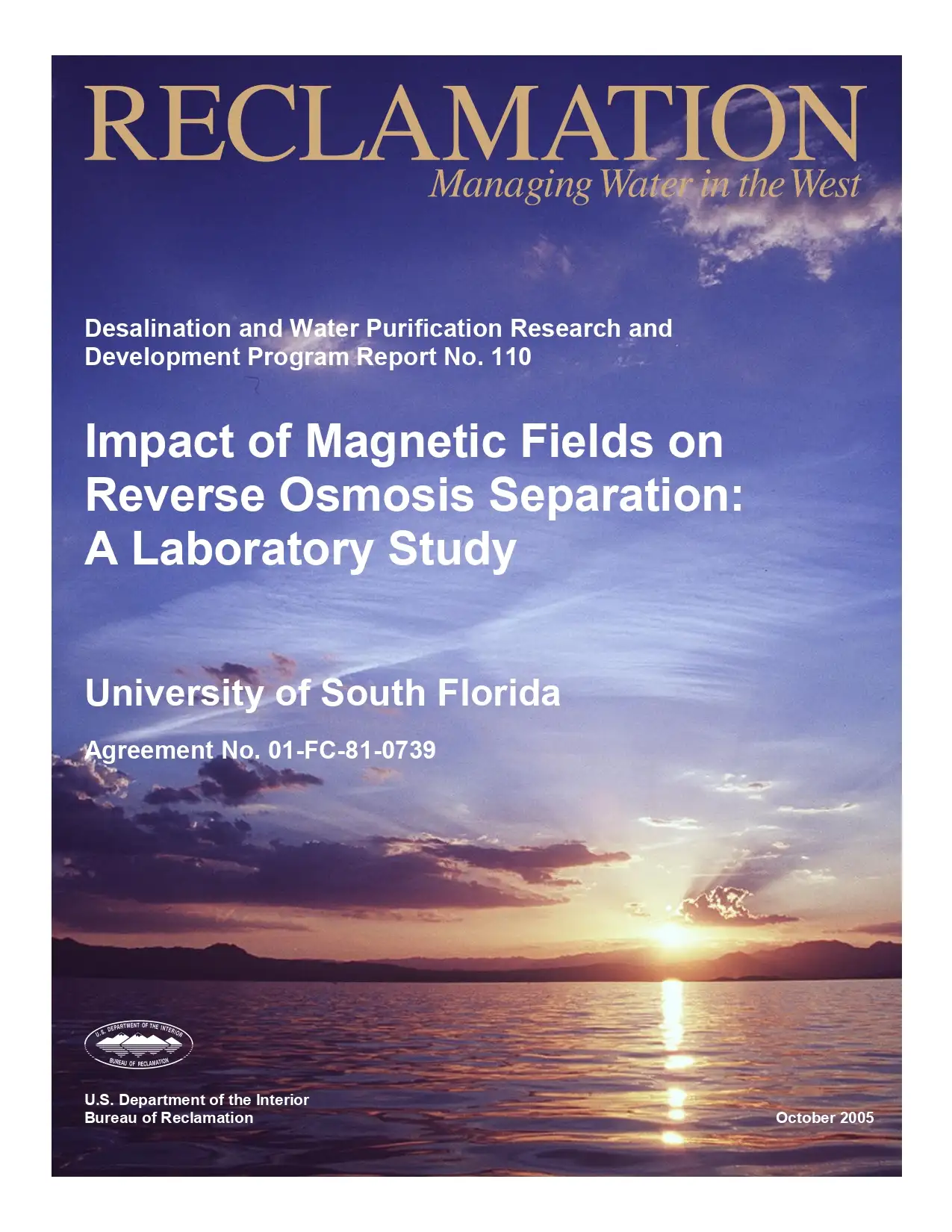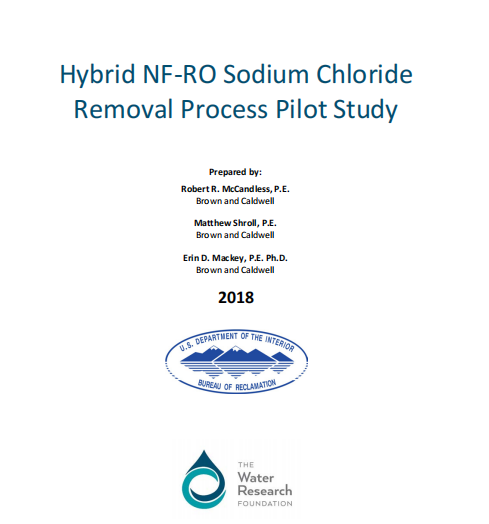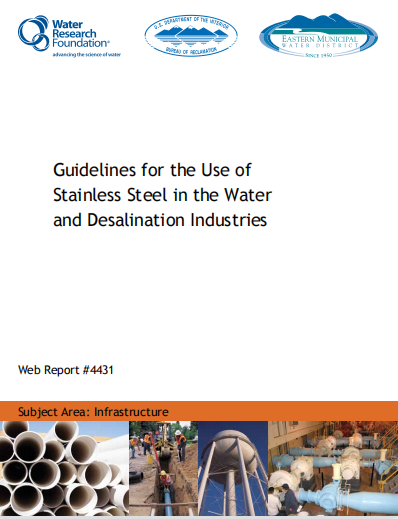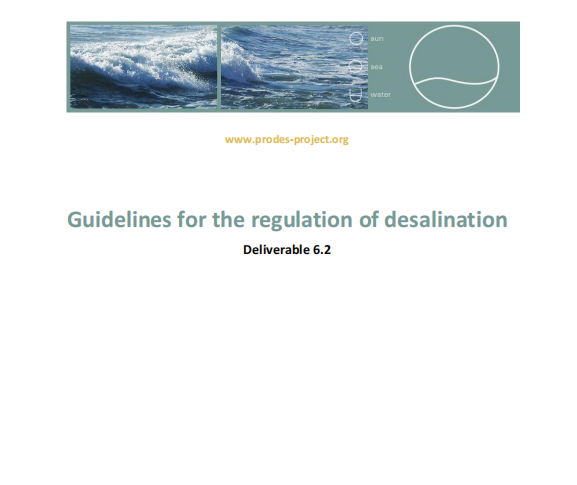Information Source Guide Water Desalination
Abstract:
While the importance of desalination has been increasing steadily over the past decades, views on the merits of desalination among water professionals differ. Some portray desalination as a panacea for much of the world's water woes. Others perceive desalination very negatively because of its alleged high costs, energy intensity and environmental impacts. While none of these extreme positions appears to be justified, it remains even more necessary to gain an objective understanding of the real stakes in desalination in the context of integrated water resources management. The World Bank has undertaken a regional study that aims at improving the understanding of desalination within the Bank and among some of its clients in the Middle East, North Africa and Central Asia. It also tries to clarify the conditions under which desalination can help in reaching the United Nation's Millennium Development Goals (MDGs) for water supply and sanitation. The study, which has been funded by the Bank-Netherlands Water Partnership, includes case studies of Algeria, Cyprus, Jordan, Malta, Tunisia and Uzbekistan. A key conclusion of the study is that desalination alone cannot deliver the promise of improved water supply. The ability to make the best use of desalination is subject to a series of wider water sector related conditions.
Information Source Guide Water Desalination
Abstract:
While the importance of desalination has been increasing steadily over the past decades, views on the merits of desalination among water professionals differ. Some portray desalination as a panacea for much of the world's water woes. Others perceive desalination very negatively because of its alleged high costs, energy intensity and environmental impacts. While none of these extreme positions appears to be justified, it remains even more necessary to gain an objective understanding of the real stakes in desalination in the context of integrated water resources management. The World Bank has undertaken a regional study that aims at improving the understanding of desalination within the Bank and among some of its clients in the Middle East, North Africa and Central Asia. It also tries to clarify the conditions under which desalination can help in reaching the United Nation's Millennium Development Goals (MDGs) for water supply and sanitation. The study, which has been funded by the Bank-Netherlands Water Partnership, includes case studies of Algeria, Cyprus, Jordan, Malta, Tunisia and Uzbekistan. A key conclusion of the study is that desalination alone cannot deliver the promise of improved water supply. The ability to make the best use of desalination is subject to a series of wider water sector related conditions.
Improved Energy Efficiency of Electrodialysis Desalination and Separation: Development of Percolating Network Nanocomposite Ion-Exchange Membranes for High Conductivity
Abstract:
Nanocomposite cation exchange membranes have been fabricated by incorporating sulphonate carbon nanotubes into sulphonate poly(p-phenylene oxide) polymer matrix (0-20 w/w%). The percolating network of carbon nanotubes can advantageously lower the intrinsic resistivity of the nanocomposite membrane while the charged functional moieties intensifies the Donnan exclusion effect, thus sustaining a high perm selectivity. Nanocomposite IEMs exhibit improved conductivity while maintaining perm selectivity. Intrinsic resistivity, inverse of conductivity, decreases 25 to 29 percent, with 20 percent incorporation of sCNT. Enhancement in conductivity is more pronounced for membranes with lower swelling degree. The nanocomposite fabrication strategy can advance the perm selectivity-conductivity tradeoff to obtain IEMs with improved performance. The electro dialysis desalination of brackish water to drinking water standards (1,000 ppm TDS) has been demonstrated with the fabricated nanocomposite membranes. Projected energy savings of about 13.3 to 15.8 percent for brackish water desalination is achievable with nanocomposite membranes. This study demonstrates the rational use of nanomaterials as a promising platform to advance the conductivity-perm selectivity trade-off governing conventional IEMs.
Improved Energy Efficiency of Electrodialysis Desalination and Separation: Development of Percolating Network Nanocomposite Ion-Exchange Membranes for High Conductivity
Abstract:
Nanocomposite cation exchange membranes have been fabricated by incorporating sulphonate carbon nanotubes into sulphonate poly(p-phenylene oxide) polymer matrix (0-20 w/w%). The percolating network of carbon nanotubes can advantageously lower the intrinsic resistivity of the nanocomposite membrane while the charged functional moieties intensifies the Donnan exclusion effect, thus sustaining a high perm selectivity. Nanocomposite IEMs exhibit improved conductivity while maintaining perm selectivity. Intrinsic resistivity, inverse of conductivity, decreases 25 to 29 percent, with 20 percent incorporation of sCNT. Enhancement in conductivity is more pronounced for membranes with lower swelling degree. The nanocomposite fabrication strategy can advance the perm selectivity-conductivity tradeoff to obtain IEMs with improved performance. The electro dialysis desalination of brackish water to drinking water standards (1,000 ppm TDS) has been demonstrated with the fabricated nanocomposite membranes. Projected energy savings of about 13.3 to 15.8 percent for brackish water desalination is achievable with nanocomposite membranes. This study demonstrates the rational use of nanomaterials as a promising platform to advance the conductivity-perm selectivity trade-off governing conventional IEMs.
Implementation of the National Desalination and Water Purification Technology Roadmap: Structuring and Directing the Development of Water Supply Solutions
INTRODUCTION:
In the United States, economic growth increasingly requires that greater volumes of freshwater be made available for new users, yet supplies of freshwater are already allocated to existing users. Currently, water for new users is made available through re-allocation of existing water supplies—for example, by cities purchasing agricultural water rights. Water may also be made available through conservation efforts and, in some locales, through the development of “new” water from non-traditional sources such as the oceans, deep aquifer brackish groundwater, and water reuse. Developing “new” water from non-traditional sources relies primarily on membrane filtration (e.g., reverse osmosis) and to a lesser extent distillation. Both are technology-intensive processes whose future depends on the development of, respectively, better membranes and more efficient heat transfer approaches. Membrane filtration in particular carries with it weighty pre- and post-treatment concerns: How to prevent the formation of filter-clogging inorganic and biologic scales? How to dispose of residual concentrated brines? How to chemically stabilize the water that is produced?
Water development in the 20th century largely involved the physical collection and transfer of freshwater by dams and aqueducts. Because of tightening supplies and public resistance to further dam building, water development in the 21st century will increasingly rely on creating or reclaiming water from non traditional sources by membrane filtration and other desalination processes. Since the latter are tied so strongly to technology, the absolute volume of new water produced in the United States in the 21st century will likely reflect the extent of new research and development investment in desalination. This has happened before. In the 1950s and 1960s, the U.S. government invested a total of roughly $900 million (in 1985 dollars) in desalination research conducted through the Office of Saline Water in the Department of the Interior. Reverse osmosis (RO) desalination is one of the notable inventions that resulted from this federal investment: RO is presently a $2 billion per year global market, and the technology is used to produce six billion gallons of water per day.
Increasing the availability of new water will likely require a renewed national commitment to
desalination research and development.
Implementation of the National Desalination and Water Purification Technology Roadmap: Structuring and Directing the Development of Water Supply Solutions
INTRODUCTION:
In the United States, economic growth increasingly requires that greater volumes of freshwater be made available for new users, yet supplies of freshwater are already allocated to existing users. Currently, water for new users is made available through re-allocation of existing water supplies—for example, by cities purchasing agricultural water rights. Water may also be made available through conservation efforts and, in some locales, through the development of “new” water from non-traditional sources such as the oceans, deep aquifer brackish groundwater, and water reuse. Developing “new” water from non-traditional sources relies primarily on membrane filtration (e.g., reverse osmosis) and to a lesser extent distillation. Both are technology-intensive processes whose future depends on the development of, respectively, better membranes and more efficient heat transfer approaches. Membrane filtration in particular carries with it weighty pre- and post-treatment concerns: How to prevent the formation of filter-clogging inorganic and biologic scales? How to dispose of residual concentrated brines? How to chemically stabilize the water that is produced?
Water development in the 20th century largely involved the physical collection and transfer of freshwater by dams and aqueducts. Because of tightening supplies and public resistance to further dam building, water development in the 21st century will increasingly rely on creating or reclaiming water from non traditional sources by membrane filtration and other desalination processes. Since the latter are tied so strongly to technology, the absolute volume of new water produced in the United States in the 21st century will likely reflect the extent of new research and development investment in desalination. This has happened before. In the 1950s and 1960s, the U.S. government invested a total of roughly $900 million (in 1985 dollars) in desalination research conducted through the Office of Saline Water in the Department of the Interior. Reverse osmosis (RO) desalination is one of the notable inventions that resulted from this federal investment: RO is presently a $2 billion per year global market, and the technology is used to produce six billion gallons of water per day.
Increasing the availability of new water will likely require a renewed national commitment to
desalination research and development.
Impact of Magnetic Fields on Reverse Osmosis Separation: A Laboratory Study
ABSTRACT:
This research investigated the effects of electromagnetic fields on salt and water transport in reverse osmosis (RO) membranes. Two experimental apparatus were considered—the PowerSurvivor-35 from PUR and a classic lab scale RO system. For both systems, the electromagnetic field was generated by a solenoid placed around the pressure vessel. The field intensity was 680 Gs, and the field frequency was 40 hertz (Hz) and 300 Hz. The studied salts were LiCl, NaCl, KCl, MgCl2, and CaCl2 at concentrations of 0.02 M, 0.05 M and 0.1 M. The preferential sorption-capillary flow model was used to calculate the transport parameters in the membrane.
Impact of Magnetic Fields on Reverse Osmosis Separation: A Laboratory Study
ABSTRACT:
This research investigated the effects of electromagnetic fields on salt and water transport in reverse osmosis (RO) membranes. Two experimental apparatus were considered—the PowerSurvivor-35 from PUR and a classic lab scale RO system. For both systems, the electromagnetic field was generated by a solenoid placed around the pressure vessel. The field intensity was 680 Gs, and the field frequency was 40 hertz (Hz) and 300 Hz. The studied salts were LiCl, NaCl, KCl, MgCl2, and CaCl2 at concentrations of 0.02 M, 0.05 M and 0.1 M. The preferential sorption-capillary flow model was used to calculate the transport parameters in the membrane.
Hybrid NF-RO Sodium Chloride Removal Process Pilot Study
Abstract:
Concentrate disposal is a major cost for desalting operations, particularly for inland sites. For many water recycling applications, only partial desalting is needed, with sodium chloride the most common target for removal. A process to preferentially remove sodium chloride could result in significant savings for concentrate treatment and disposal. A pilot study was conducted to demonstrate the viability of one such approach. This pilot study examined the salt passage characteristics of several nanofiltration (NF) membranes to segregate sodium chloride from other dissolved ions. The pilot study testing unit used a two-pass system, combining an NF pass with a second reverse osmosis (RO) pass. In this approach, unlike typical two-pass systems, the concentrate from the first NF pass is blended with the permeate from the second RO pass. Since the NF effectively retains total organic carbon (TOC), chemicals of emerging concern (CECs), and any pathogens, these contaminants are blended into the product water. Thus, further treatment may be necessary for potable reuse applications. The pilot study consisted of a scalable two-pass NF-RO membrane system operated in parallel with full scale RO units. Water quality, power consumption, and chemical consumption were tracked for 6 months at varying system conditions. Findings indicate that sodium chloride can be preferentially removed from the reclaimed water, chemical and power consumption can be reduced when operated at system recoveries comparable to typical RO systems, and much higher recoveries are achievable with modest increases in power and chemical usage.
Hybrid NF-RO Sodium Chloride Removal Process Pilot Study
Abstract:
Concentrate disposal is a major cost for desalting operations, particularly for inland sites. For many water recycling applications, only partial desalting is needed, with sodium chloride the most common target for removal. A process to preferentially remove sodium chloride could result in significant savings for concentrate treatment and disposal. A pilot study was conducted to demonstrate the viability of one such approach. This pilot study examined the salt passage characteristics of several nanofiltration (NF) membranes to segregate sodium chloride from other dissolved ions. The pilot study testing unit used a two-pass system, combining an NF pass with a second reverse osmosis (RO) pass. In this approach, unlike typical two-pass systems, the concentrate from the first NF pass is blended with the permeate from the second RO pass. Since the NF effectively retains total organic carbon (TOC), chemicals of emerging concern (CECs), and any pathogens, these contaminants are blended into the product water. Thus, further treatment may be necessary for potable reuse applications. The pilot study consisted of a scalable two-pass NF-RO membrane system operated in parallel with full scale RO units. Water quality, power consumption, and chemical consumption were tracked for 6 months at varying system conditions. Findings indicate that sodium chloride can be preferentially removed from the reclaimed water, chemical and power consumption can be reduced when operated at system recoveries comparable to typical RO systems, and much higher recoveries are achievable with modest increases in power and chemical usage.
Guidelines for the Use of Stainless Steel in the Water and Desalination Industries
This study was jointly funded by the Water Research Foundation (WRF), Eastern Municipal Water District (EMWD), and the U.S. Bureau of Reclamation (Reclamation). WRF, EMWD, and Reclamation assume no responsibility for the content of the research study reported in this publication or for the opinions or statements of fact expressed in the report. The mention of trade names for commercial products does not represent or imply the approval or endorsement of WRF, EMWD, or Reclamation. This report is presented solely for informational purposes.
Guidelines for the Use of Stainless Steel in the Water and Desalination Industries
This study was jointly funded by the Water Research Foundation (WRF), Eastern Municipal Water District (EMWD), and the U.S. Bureau of Reclamation (Reclamation). WRF, EMWD, and Reclamation assume no responsibility for the content of the research study reported in this publication or for the opinions or statements of fact expressed in the report. The mention of trade names for commercial products does not represent or imply the approval or endorsement of WRF, EMWD, or Reclamation. This report is presented solely for informational purposes.
Guidelines For The Regulation Of Desalination
Introduction
This report aims to develop guidelines for legislation addressing drinking water quality and environmental protection aspects related to desalination driven by renewable energy (RE‐ Desalination). At the same time ways to remove some of the barriers RE‐Desalination is facing are recommended in order to assist a deployment of these facilities for an improved access to safe and sustainable drinking water in regions of water scarcity.
The report has been developed within the ProDes project which is promoting the market development of desalination driven by renewable energies in Southern Europe. ProDes is co‐funded by the European Commission through the Intelligent Energy Programme and has been supporting RE‐Desalination through various activities like training for professionals and students, seminars and technical publications. Extensive information about ProDes, the partners and the results is published on the project website: www.prodes‐project.org.
The report includes an overview of currently existing guidance on desalination driven by renewable energies followed by an analysis of health, environmental and administrative aspects critical for the development of guidelines. General recommendations of elements to be included in guidelines are developed from a literature analysis. To what extent these qualify for application in various circumstances should be tested in additional country‐specific studies
Guidelines For The Regulation Of Desalination
Introduction
This report aims to develop guidelines for legislation addressing drinking water quality and environmental protection aspects related to desalination driven by renewable energy (RE‐ Desalination). At the same time ways to remove some of the barriers RE‐Desalination is facing are recommended in order to assist a deployment of these facilities for an improved access to safe and sustainable drinking water in regions of water scarcity.
The report has been developed within the ProDes project which is promoting the market development of desalination driven by renewable energies in Southern Europe. ProDes is co‐funded by the European Commission through the Intelligent Energy Programme and has been supporting RE‐Desalination through various activities like training for professionals and students, seminars and technical publications. Extensive information about ProDes, the partners and the results is published on the project website: www.prodes‐project.org.
The report includes an overview of currently existing guidance on desalination driven by renewable energies followed by an analysis of health, environmental and administrative aspects critical for the development of guidelines. General recommendations of elements to be included in guidelines are developed from a literature analysis. To what extent these qualify for application in various circumstances should be tested in additional country‐specific studies



